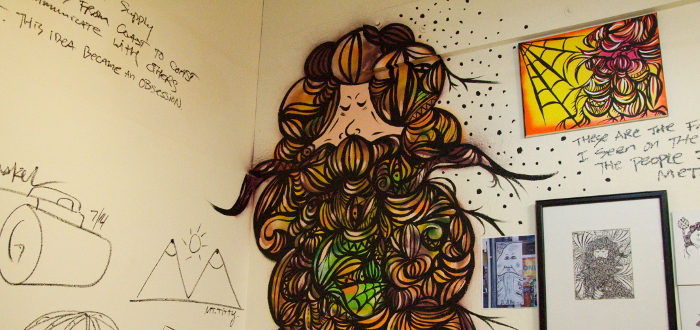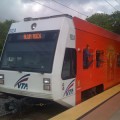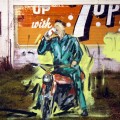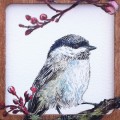Artists are usually eager to attach their names to their work. But when the art in question is also considered vandalism, signing the same name that appears on your birth certificate could land you on the wrong side of the law. As such, discretion is key for the two artists currently exhibiting their work at The Arsenal.
The compelling new show features “vandal” artists Hank Miller and Steven Bay (not their real names), both of whom have made a name for themselves—just not their real names—producing railcar art and documenting the vagabond subculture surrounding it. The show features a huge variety of work, especially for such a small space: old newspaper clippings on boxcar art, drawings, paintings, sketches and photographs—all focused on the underworld of trains, stations and yards, along with the “hobos” who live and create therein.
“Hank Miller” is an artist/railroad historian perhaps best known by his moniker: a simple, curvy steamroller signed Ed Haskey. Monikers are simple line drawings made in pastel or crayon that serve as personal brands for boxcar artists.
Miller, now middle-aged, has spent considerable time living in the underground train culture, as well as working for a railroad company. He has a deep appreciation of trains, switching yards, and the lifestyle, including the language and symbology, of those who ride the rails.
As for his more “conventional art,” that is, not the work he inscribes on boxcars and buildings, Miller draws the people he used to see in those railyards—mostly hardened, bearded men wearing secondhand clothes, trapped in the barren world of switching yards and stations.
Whereas Miller’s best work is typically seen on the sides of trains, Steven Bay presents a collection of photographs and drawings that illustrate the transient, rail-riding lifestyle.
Much of his work came about because, as Bay puts it, “I like adventure.” And it shows. His work captures the outliers of America’s vast transit culture: runaways, rail workers and vagrants—all with a natural serenity; lonely and tranquil landscapes; mystical portraits and, in a change of pace, thrilling action on the periphery of trains or train yards. His casual drawings take inspiration from abstract expressionism and cubism. “I like to draw characters more than humans,” he says.
“Vandal” art may seem like a hidden, evanescent world, perhaps even more so than conventional graffiti. But monikers are, in fact, surprisingly influential and enduring.
Marking who you are, where you’ve been, with what’s on your mind—and then leaving it for others to find—is an even older tradition, perhaps as old as humanity itself. And that shared desire is what makes the Arsenal show so resonant. As Miller puts it, it’s “spreading news, venting … anything I wanted to say.”

 Review: Tava Indian Kitchen Lets Diners Build Their Own Burroti
Review: Tava Indian Kitchen Lets Diners Build Their Own Burroti  Interview: Husband and Wife Team Brings Mooyah Burgers to Morgan Hill
Interview: Husband and Wife Team Brings Mooyah Burgers to Morgan Hill 


